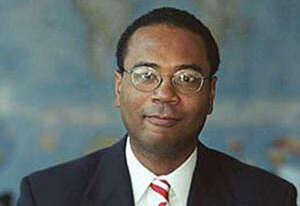
Industry holds its breath on impact of Trump diversity training order
The executive order President Donald Trump signed last week to ban certain types of diversity training carries enormous potential penalties for federal contractors.
The DoD Reporter’s Notebook is a weekly summary of personnel, acquisition, technology and management stories that may have fallen below your radar during the past week, but are nonetheless important. It’s compiled and published each Monday by Federal News Network DoD reporters Jared Serbu and Scott Maucione.
How will Trump administration’s new restrictions on diversity and inclusion training affect contractors? Unsure
The executive order President Donald Trump signed last week to ban certain types of diversity training carries enormous potential penalties for federal contractors. But at least for the time being, the vendor community appears to be holding its breath while it figures out exactly what the EO means.
Starting Nov. 21, with few exceptions, every federal contract will include a clause that bars companies from conducting training that runs afoul of a list of criteria the White House objects to (see below for the list). Companies who are deemed to have violated the restrictions also face cancellation of all their existing contracts, plus suspension or debarment from future awards. Similar restrictions apply to federal grantees.
Firms who do business with the government will also have to impose the same training restrictions on their subcontractors, and the rules apply whether a company has thousands of government contracts or it’s filling a single order. To spot violators, the EO also orders the Labor Department to set up a special hotline to gather complaints and investigate companies with suspect training programs.
Three large industry associations Federal News Network contacted for this story declined to comment or did not respond. The Aerospace Industries Association said it was still studying the issue.
The one association that has weighed in, the Information Technology Industry Council (ITI), issued a strong denunciation of the order last week, mostly on policy grounds.
But even ITI says it’s impossible, for now, to know the extent to which the prohibitions laid out in the EO will have an impact on companies’ training programs in the real world, considering the way the order was drafted.
“And that’s part of the reason that we’ve raised concerns about this executive order. It could be the case that hundreds of thousands of federal government contractors will have to submit their training and education programs to the federal government for review,” Jason Oxman, ITI’s president and CEO said in an interview. “What we have here is an executive order that imposes — without any congressional input, without any input from agencies, without any rulemaking processes or procedures — a brand new requirement on all federal contracts that says you have to do a training program in a particular way. And if you do a training program in a different way, you’re going to lose your federal contracts. That’s unheard of.”
The order doesn’t offer any indication as to whether the Trump administration believes the “race and sex stereotyping” training it objects to is widespread among government contractors. It’s also not clear whether the White House has gathered any data on the subject thus far; indeed, the EO includes a provision telling the Office of Management and Budget to send vendors a request for information on their diversity and inclusion training within the next 30 days.
Oxman said it’s too early to predict whether industry groups will launch a lobbying effort to block the new requirements in Congress or challenge them in court. But he said the order presented serious legal and constitutional questions.
In a note to clients on Friday, the law firm Venable also said the order could violate companies’ First Amendment rights and create “tension” with existing federal laws that encourage diverse workforces among federal contractors.
“The EO is no doubt a reaction by the administration to quell perceived anxieties over various training and communication/discussion programs implemented by many companies and organizations as a result of recent social and racial justice concerns sweeping the country,” attorneys Dismas Locaria and Krista A. Nunez wrote. “The legal underpinnings of the EO raise serious questions and may be subject to challenge, but, as implemented in its current form, it imposes broad restrictions with dire consequences on how companies and organizations conduct themselves in relation to these important issues, even with their own private funding.”
But Larry Allen, the president of Allen Federal Business Partners, said he believes the overall impact of the executive order will be fairly minor.
“I think the executive order points out that in the United States we have a slew of anti-discrimination rules — you’re not allowed to discriminate against somebody’s race or gender — and to the extent you have training materials that are inconsistent with those protections, they’re going to have to be modified,” he said. “But I don’t believe that’s a real significant number.”
Indeed, the order frames the training the White House finds objectionable in anti-discrimination language — alleging that “many people” are advocating a “pernicious and false belief that America is an irredeemably racist and sexist country; that some people, simply on account of their race or sex, are oppressors.” It adds that no training materials should cause people to “feel discomfort, guilt, anguish, or any other form of psychological distress on account of his or her race or sex.”
For contractors, it forbids training that “inculcates” in their employees the concepts that:
- One race or sex is inherently superior to another race or sex
- An individual, by virtue of his or her race or sex, is inherently racist, sexist, or oppressive, whether consciously or unconsciously
- An individual should be discriminated against or receive adverse treatment solely or partly because of his or her race or sex
- Members of one race or sex cannot and should not attempt to treat others without respect due to race or sex
- An individual’s moral character is necessarily determined by his or her race or sex
- An individual, by virtue of his or her race or sex, bears responsibility for actions committed in the past by other members of the same race or sex
- Any individual should feel discomfort, guilt, anguish, or any other form of psychological distress on account of his or her race or sex
- Meritocracy or traits such as a hard work ethic are racist or sexist, or were created by a particular race to oppress another race
And although the administration has not yet provided examples of contractor training programs that it believes would violate those rules, they’re written broadly enough that they could be interpreted to apply to a wide variety of existing programs in and outside the government, said Lynne Bernabei, an employment discrimination and civil rights attorney with the firm Bernabei & Kabat.
“They’re forbidding certain kinds of training that have been used to eradicate discrimination in the federal government, and that’s largely discrimination on the basis of race, ethnicity and gender. What they’re saying here is that you can’t do that anymore,” she said. “You have to assume everybody’s equal, and we’re going to withdraw federal contracts or punish you if you try train people on how not to discriminate. Basically they’re saying the assumption is nobody ever discriminates, and if you have any training that tries to teach people that there are ways, overt and subtle, in which people discriminate … then you’re going to get your federal funds or your grants or job taken away.”
Allen’s interpretation was much narrower.
“This is probably going to affect only a handful of companies, but now that they know what the rules are, I think they’re going to have an opportunity to amend their training,” he said. “It doesn’t say you can’t teach diversity training — you can still do that. I’m sure most companies will do some due diligence and review their training materials and their slides, but I’m not sure this going to cause a wave of updates of things. I think it’s going to be at the margins.”
But whether the impact is marginal or implicates hundreds of thousands of firms, as Oxman fears, the ways in which the order attempts to regulate private businesses by executive fiat is a major cause for concern in and of itself, he said.
“We have an executive order that essentially says you probably shouldn’t do any training that addresses racial disparities and a history of oppression of minorities in the United States. We don’t want you to do that training, and if you do, we will suspend or debar you in 60 days. And the question is, is that something as a matter of policy and process that should be done in an executive order? Our answer is definitively no,” Oxman said. “That’s not to say that government can’t coerce behavior by companies through the contracting process. It can. But that’s not something that’s ever done by executive order, it’s not something the law would allow to be done by executive order, and why we’re raising some concerns here.” —JS
Schism brewing in Congress over CMO position
Thirteen senators and representatives are calling on the Congressional armed services committees to reconsider getting rid of the Defense Department’s third highest position.
In a letter signed by Sens. Joe Manchin (D-W.V.), Elizabeth Warren (D-Mass.) and Joni Ernst (R-Iowa), the legislators make the case that the Pentagon’s chief management officer position deserves a second shot.
“Alarmingly, both the House-and Senate-passed 2021 defense authorization bills would abruptly terminate the CMO position and transfer those responsibilities back to the deputy secretary of defense. We already tried that in 2007. It did not work,” the lawmakers wrote. “The fundamental problem plaguing the CMO position is a lack of authority and resources. Rather than further eroding the limited authority that currently exists, we should come together to demonstrate the broad, bipartisan support that exists for this important position.”
The senators noted the current CMO, Lisa Hershman, has only been in the job since last December and that a Government Accountability Office report suggested a tenure of five to seven years.
The CMO is tasked with saving the department money and helping streamline practices to help DoD run better.
“Let us at least give Ms. Hershman a fighting chance, and come together to adopt the changes needed to make this position work. The U.S. taxpayers that we represent deserve that,” they wrote.
Congress started considering getting rid of the CMO position back in May when a Defense Business Board report found the CMO didn’t deliver on its mission of business transformation, not because of the failings of any of its leaders but because it lacked the authority to drive change.
The board offered a few other alternatives to the CMO, which the NDAA seems to support. — SM
After e-planes, are e-satellites next?
The Air Force is starting to design its future aircraft with digital engineering, a process that uses digital models instead of prototypes to save money. But what about satellites?
The Air Force and Space Force are heavily invested in technology orbiting the Earth. Air Force acquisition chief Will Roper said the service is embarking on two classified programs that may be the first digitally designed satellites.
However, they won’t follow the same trajectory as aircraft.
“It’s going to take a little longer than where we are with aviation, because it’s just at the beginning,” Roper told reporters last week. “What I encountered with digital engineering is a lot of people saying ‘We’re already doing it.’ But, using a computer to design something and equating it to digital engineering and the magic I’ve seen from it would be like presuming that all sculptures that are made with hammers and chisels would all turn out to be Michelangelos.”
Roper said there are a number of barriers keeping e-satellites from getting in the air as fast as e-planes.
“The supply base isn’t there,” Roper said. When you go to digital engineering, I have wonderful models that integrate design and assembly, and even operations. If my supply base doesn’t build parts that align with those models, especially their tolerances, then I actually don’t have a digital thread, because I cut it at the beginning. Step one is programs building up their digital thread and then working with vendors to tighten up their supply base to meet those tolerances.”
Roper said that process will take a couple of years.
From there, the Air Force and Space Force need to change the way they look at design. Roper said the point of a digital thread moving through the process is to fundamentally change how satellites are built and how they operate.
Roper is asking his e-satellite programs to cut out difficult and expensive processes.
“Let’s get rid of the high tolerance cleanrooms the expensive tooling, the highly experienced workforce, the rigging and harnessing the things that makes satellites expensive,” Roper said. “Let’s see if we can design them out and get something that’s more like a Toyota SAP.”
Toyota SAP is the data platform the car company uses to share information and analyze data. — SM
Air Force’s AFWERX gets bumped to major leagues
The Air Force’s innovation hub, AFWERX, is getting a promotion and will be reporting directly to the service’s leadership at the Pentagon, much like a program executive office.
“Given the daunting challenges we face against peer competitors, the operative question is: ‘What are we doing to tip the scales?’” Air Force acquisition chief Will Roper wrote a Sept. 1 memo. “One answer is relaunching AFWERX with expanded authority. “With so much of the battlefield — over 80% — in commercial markets having a frontline organization bridge back to our PEOs, research labs and major commands can lower our fence line, multiply our partnerships and provide a plain-speaking menu for defense work where the first course isn’t acronym soup.”
The memo breaks AFWERX into three different branches: AFVentures, Spark and Prime.
AFVentures will focus on courting commercial markets to solve military problems by partnering with startups and increasing the service’s awareness of technologies in the private sector.
“The fact that the AFVEntures process connects to the big ‘A’ acquisition system is what’s making private investors continue to raise their hands and want to determine how they bring more companies through it,” Roper told reporters last week. “I do more engagements with venture capitalists and private investors than any other group. I cannot fill my calendar up enough with it because they all want to understand how they tap this emerging market for them that a market that’s been here a long time that has a very different ruleset.”
The Spark branch is focused on empowering innovation at the operational edge.
“Spark connects amazing airmen and space professionals to commercial innovators using virtual collaboration, immersive training and networking opportunities that inspire ideas and cultivate creative forces,” the memo states. “By connecting operators closer to acquisition, Spark provides both a voice and conduit to turn powerful ideas into powerful operational realities.”
The branch will also continue to run AFWERX’s Spark Cells, Tanks and Challenges, which challenge airmen to innovation and offer prizes.
The Prime branch will leverage other unique government resources by working with other agencies, programs and emerging markets. The Air Force’s Agility Prime program, which is trying to develop flying cars, falls under this branch.
Roper said Prime will have another project by the end of the year.
In the memo, Roper also left room for more branches as AFWERX grows. — SM
DoD wants new joint requirements for data
The Defense Department is planning on publishing new joint requirements for data next year that will allow the Pentagon to manage it from a top capabilities and attributes level.
Vice Chairman of the Joint Chiefs of Staff Gen. John Hyten said DoD wants to change the way it manages data so that by 2030 the loads of information the Pentagon collects will be easily digestible.
The requirements will come from the Joint Requirements Oversight Council and be pushed down to the services.
“They’re not going to be the traditional requirements and capability description documents and capability production documents that you’ve looked at for years,” Hyten said. “They’re going to be capability attributes that programs have to have. If you don’t meet those, you don’t meet the job requirements, and therefore you don’t get through the gate and you don’t get money.”
The requirements will not just be for data, they will also reach to software, contested logistics, all domain command and control and joint fires.
Hyten said this is different from how JROC acts now.
“The way that process has worked is a service develops a capability, it comes up through the various coordination boards, eventually getting to the JROC,” he said. “We validate a service concept and make sure it meets the joint interoperability requirements.”
Hyten said the hardest part of creating the top down approach will be wording the requirements to ensure they hold up and achieve the goals DoD is working on for the next 10 years. — SM
Copyright © 2025 Federal News Network. All rights reserved. This website is not intended for users located within the European Economic Area.
Jared Serbu is deputy editor of Federal News Network and reports on the Defense Department’s contracting, legislative, workforce and IT issues.
Follow @jserbuWFED
Scott Maucione is a defense reporter for Federal News Network and reports on human capital, workforce and the Defense Department at-large.
Follow @smaucioneWFED






